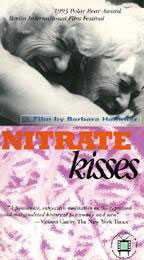Nitrate Kisses
| Nitrate Kisses | |
|---|---|
 | |
| Directed by | Barbara Hammer |
| Produced by | Barbara Hammer |
| Written by | Barbara Hammer |
| Narrated by | Barbara Hammer |
| Cinematography | Barbara Hammer |
| Edited by | Barbara Hammer |
| Distributed by |
Frameline Strand Releasing |
Release dates |
September 12, 1992 (Toronto) April 9, 1993 (USA) |
Running time | 67 mins. |
| Country | United States |
| Language | English |
Nitrate Kisses is a 1992 experimental documentary film directed by Barbara Hammer. According to Hammer, it is an exploration of the repression and marginalization of LGBT people since the First World War.[1]
Overview
Nitrate Kisses combines interviews with homosexual couples, four same-sex couples making love, footage of 1933 homoerotic film Lot in Sodom and images of LGBT history.[1][2] The couples making love are two elderly lesbians, an interracial gay male couple, two young pierced and tattooed women of color and an S/M lesbian couple.[3] The scenes of the gay male couple are overlaid with the Motion Picture Production Code.[4]
Part of the film focuses on the story of American novelist Willa Cather, who destroyed many personal letters and papers before her death; the film argues that Cather was covering up evidence of lesbianism.[1] (Note, however, that such claims have been disputed by other scholars of Cather's life and career.[5]) Another section explores the treatment of lesbians by the Third Reich.[6]
Background
Hammer received funding from the National Endowment for the Arts to help finance Nitrate Kisses, which was her first feature film.[7][8] She decided she wanted to make a film about the most marginalized groups within the queer community. When choosing which couples to film having sex, she decided to feature a mixed-race couple and asked two friends of hers, Jack Waters and Peter Cramer.[7] She then met a young lesbian couple who were both women of color, and were pierced and tattooed, with shaved heads. She filmed them making love in a sculpture of a burnt out house, which Hammer felt represented "a history we don't have."[7] Next, she met a lesbian couple who arrived to shoot their scene with S/M paraphernalia.[9] When looking for her fourth couple, Hammer decided that she wanted to explore ageism in the lesbian community. She went to an awards ceremony for older lesbians and chose a woman called Frances Lorraine who performed in the film with a friend.[9] In an interview for Alexandra Juhasz's book Women of Vision: Histories in Feminist Film and Video, Hammer called Nitrate Kisses her best work.[9]
Distribution and reception
Nitrate Kisses premiered at the Toronto Film Festival on September 12, 1992 and has been shown at several other film festivals internationally.[10] It was shown theatrically in New York, Los Angeles, San Francisco, Chicago and Austin, distributed by Strand Releasing.[1][10] It was released on VHS on December 16, 1998.[11]
It was nominated for the Grand Jury Prize at the 1993 Sundance Film Festival. It won the Polar Bear Award at the Berlin International Film Festival and the Best Documentary Award at the Internacional de Cine Realizado por Mujeres in Madrid.[12]
References
Notes
- ↑ 1.0 1.1 1.2 1.3 Canby, Vincent (1993-04-09). "Nitrate Kisses (1992) Review". The New York Times. Retrieved 2008-05-10.
- ↑ "Nitrate Kisses - Synopsis". Official Barbara Hammer site. Archived from the original on 2008-03-06. Retrieved 2008-05-10.
- ↑ Foster, p.124
- ↑ Mellencamp, p.305
- ↑ "Cather did not label herself a lesbian nor would she wish us to do so, and we do not know whether her relationships with women were sexual." Sharistanian, Janet. Introduction to My Ántonia, New York: Oxford University Press, 2006, p. xiii.
- ↑ Holmlund, p.84
- ↑ 7.0 7.1 7.2 Juhasz, p.85
- ↑ Hallam, p.53
- ↑ 9.0 9.1 9.2 Juhasz, p.86
- ↑ 10.0 10.1 "Barbara Hammer". Women Make Movies. Retrieved 2008-05-13.
- ↑ "Nitrate Kisses". Amazon.com. Retrieved 2008-05-13.
- ↑ "Nitrate Kisses - Awards and Screenings". Official Barbara Hammer site. Retrieved 2008-05-10.
Sources
- Foster, Gwendolyn Audrey (2004). "Barbara Hammer". In Duchovnay, Gerald. Film Voices: Interviews from Post Script. SUNY Press. pp. 109–127. ISBN 0-7914-6156-4.
- Hallam, Paul (1995). The Book of Sodom. Verso. ISBN 1-85984-042-6.
- Holmlund, Chris; Cynthia Fuchs (1997). Between the Sheets, in the Streets: Queer, Lesbian, Gay Documentary. University of Minnesota Press. pp. 82–89. ISBN 0-8166-2775-4.
- Juhasz, Alexandra (2001). Women of Vision: Histories in Feminist Film and Video. University of Minnesota Press. pp. 84–87. ISBN 0-8166-3372-X.
- Mellencamp, Patricia (1995). A Fine Romance: Five Ages of Film Feminism. Temple University Press. ISBN 1-56639-400-7.